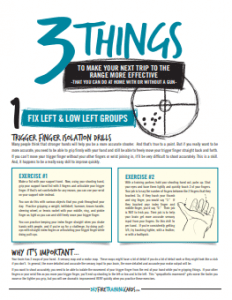I have got a fun article for you today that’s somewhat timely with the Olympics coming up.
Did you know that 32% of people polled before the Sydney Olympics wanted pistol dueling to be REINSTATED?
Not “introduced,” but “reinstated.”
As in, pistol dueling used to be an actual Olympic sport!
There were actually 2 different versions…
Full-contact 20M and non-contact 20M & 30M.
Here’s how it played out.
Around the turn of the century (1900), a doctor and target shooter named Dr. Paul Devillers created a 1g wax bullet made of tallow (rendered animal fat) and baryta sulphate (paper whitener used for photography) that wouldn’t break up in the gun and would splatter when it hit.
They were propelled by primers and had a muzzle velocity of just over 300fps.
Depending on the temperature, projectiles were stored in a box, in water, or on ice. This variability meant that the effect of impact could vary considerably.
With his patented bullet, in 1903, Devillers convinced a French gun manufacturer, Piot-Lepage to make special dueling pistols with handguards. (Handguards were necessary because of some wicked hand injuries)
It became popular enough that the Societie L’Assaut au Pistolet was formed in 1904 and they held weekly Friday matches in Paris near the Arc de Triomphe.
 Things progressed quickly, and by 1906, dueling was an official Olympic sport, with medals for 20m and 30m distances…although the targets were plaster manikins instead of fellow participants. The 6 medalists were a mix of French, Italian, Greek, and Swedish duelists.
Things progressed quickly, and by 1906, dueling was an official Olympic sport, with medals for 20m and 30m distances…although the targets were plaster manikins instead of fellow participants. The 6 medalists were a mix of French, Italian, Greek, and Swedish duelists.
That changed by 1908.
The best duelers in the world happened to mostly be fencers who were competing at the 1908 Olympics.
So they showed up on the fencing grounds 11 days before they were supposed to fence and proceeded to put on a full-contact dueling demonstration before a select crowd…mostly press.
Mano a mano. Man facing man. No plaster dummies this time.

From the demonstration at the Olympics, the sport exploded, with dueling clubs at both the Carnegie Sword and Pistol Club in New York AND the NY Athletic Club.
But that was before the Great War.
The Great War ended dueling as a sport that had near-term potential of being re-instated as an Olympic sport.
And that brings us to today.
The modern equivalent to dueling is force-on-force training with marker rounds like simunition, UTM, T4E Paintball, or airsoft.
When most people think about force-on-force, they think about complex, large scale, immersive scenario training.
Those can be awesome, but for most people, the change in complexity from shooting paper to fully-immersive force-on-force is too big of a jump. There are too many contextual changes.
That jump tends to create very strong emotional, episodic memories of force-on-force training, but very little actual skill.
That’s why great force-on-force instructors do a lot of “frag” drills (fragment drills) and isolation drills.
“Frag” drills are mini-scenarios that are very quick to set up and very quick to run (and re-run) so that you can correct errors in real time.
With isolation drills, the instructor breaks down a complex force-on-force scenario and figures out the individual skills that a shooter needs to perform to have a high chance of success.
They also figure out the factors that are different between how the student has trained in the past and how they need to perform in the force-on-force training.
-Flat footed, perfect stance shooting vs. shooting effectively from any foot position.
-Shooting with static vision vs. shooting with dynamic vision.
-Shooting with static balance vs. shooting with dynamic balance.
-Shooting based on audible commands vs. changing, fluid, visual input.
-Shooting straight ahead vs. shooting at odd angles.
-Shooting with low stress or anticipatory performance stress vs. the immediate stress that comes with an aversion to being shot.
The bigger the difference between how the shooter has practiced in the past and the conditions of the force-on-force training, the harder it is for the shooter to do well in the force-on-force training.
They practice the individual skills and quickly progress to drills that combine 2, then 3, then more of the skills in a single drill until the shooter is able to handle the complex force-on-force drill.
And, of course, it’s the same for self-defense shooting.
The bigger the difference between how someone trains and the conditions that are imposed on them in real life, the more their performance will drop off.
That’s why it’s vital that you do training on a regular basis that incorporates factors from the real world.
And, whether you’re trying to get up to speed for an upcoming force-on-force training or training for self defense, the absolute best at-home training program is our Praxis Dynamic Gunfight Training.
You can get a special package discount on Praxis training and the T4E paint markers >HERE< or you can find out more about the Praxis training on it’s own >HERE<

Leave A Response